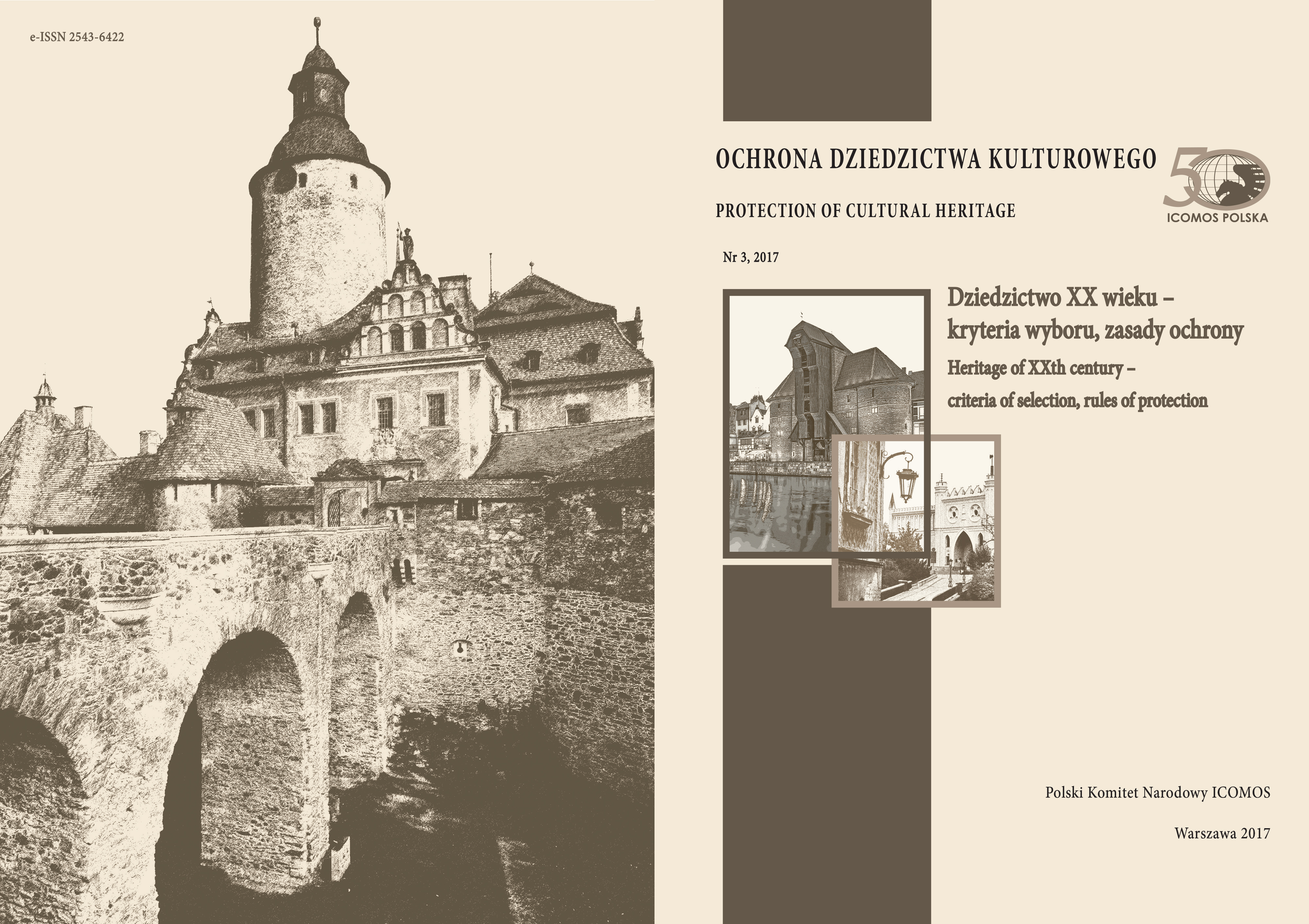Monuments of modernism as a defined resource of architectural heritage in the context of post-war facilities protection
Article Sidebar
Open full text
Issue No. 3 (2017)
-
Protection of contemporary cultural goods in Lodz planning documents - defining the resource and rules of protection
Maria Dankowska7-18
-
Conservation issues and assumptions for the protection of objects of the former KL Auschwitz-Birkenau
Jolanta Banaś-Maciaszczyk, Rafał Pióro19-28
-
Copyright protection of the 20th century cultural heritage
Wojciech Kowalski29-44
-
The legacy of post-war architecture in Poland as a record of political, social and economic changes
Małgorzata Rozbicka45-68
-
Protection of cultural goods in the 2nd half of the XXth century in Silesia. Urban design, architecture, sculpture, mural
Helena Jadwiszczok-Molencka, Jacek Molencki69-85
-
How young can a monument be? The normative premises of stating the "validity" of immovable monuments
Marek Świdrak87-94
-
Authenticity versus sharing. Boundaries of compromises in the preservation of the former Auschwitz-Birkenau camp
Anna Łopuska95-106
-
Evaluation of the value of modernism monuments from the 1st half of the XXth century. Proposals of the classification methods
Jakub Lewicki107-124
-
Modernism as a particularly important Polish 20th century heritage. Criteria for selection and protection of modernist resource on the example of Stalowa Wola architecture
Grażyna Stojak125-131
-
Searching for criteria for the evaluation of modern wall paintings in historic churches in Poland
Małgorzata Korpała133-145
-
Industrial heritage - unwated heritage - unknown heritage
Jacek Dąbrowski147-160
-
Legacy of modernity in Japan - categories of valuation and examples
Waldemar J. Affelt161-178
-
Monuments of modernism as a defined resource of architectural heritage in the context of post-war facilities protection
Maciej Czarnecki179-186
Main Article Content
DOI
Authors
Abstract
Modern movement in architecture of the twentieth century image diverse in terms of trends and tendencies and also consistent in terms of characteristics and evaluation criteria. So assumption is aimed at:
– Separation of the main directions of modernism with an emphasis on diversity of forms and spatial systems;
– Demonstrate common features ideological, artistic, stylish – allow for a holistic treatment of Modernism as a movement with the characteristics of the architectural style.
These assumptions should be regarded as crucial to the prospects for the protection of post-war modernist architecture. Many pre-war buildings listed in the register of monuments and in the municipal records for. Numerous studies over the interwar modernism facilitate assessment of the value, to determine the characteristics and restoration of this architecture.
Most of the realization of being an example of post-war modernism is not protected, functioning in the collective consciousness as objects too contemporary to treat them as historical monuments. Their ideological characteristics, formal, functional and technological – are not often used in so far classification and valuation of objects recommended for protection.
The article is an attempt to summarize the objects typical of selected trends of the inter-war period realizations depicting post-war trends of modern architecture in order to show that modernism was a movement that should be treated holistically as stylistically consistent, time-limited period of twentieth century architecture.
Keywords:
References
Bieniecki Z., Potrzeba i drogi ochrony obiektów architektury najnowszej, „Ochrona Zabytków”, R. XXII, 1969 nr 2.
Lewicki J., O początkach klasyfikacji zabytków. O wadach i zaletach polskich systemów wartościowania zabytków, [w:] B. Szmygin (red.), Ochrona dziedzictwa kulturowego. Klasyfikacja i kategoryzacja w systemie ochrony zabytków, Warszawa 2016.
Schulz S., Schulz C. G., Das Hansaviertel. Ikone der Moderne, Berlin 2008.
The Olivetti Showroom, (red.) Dal Co Francesco, Dina Lucia Borromeo, 2011.
Ustawa z dnia 23 lipca 2003 r. o ochronie zabytków i opiece nad zabytkami.
Witwicki M. T., Kryteria oceny wartości zabytkowej obiektów architektury jako podstawa wpisu do rejestru zabytków, „Ochrona Zabytków”, R. LX, 2007 nr 1.
http://docomomo-us.org/programs/awards (dostęp: 9.03.2017).
http://flwright.org/ (dostęp: 9.03.2017).
http://whc.unesco.org/en/list/445 (dostęp: 10.03.2017).
http://whc.unesco.org/en/tentativelists/5249/ (dostęp: 9.03.2017).
Article Details
Abstract views: 366
Maciej Czarnecki, Faculty of Architecture, Warsaw University of Technology
dr inż. architekt, adiunkt na Wydziale Architektury Politechniki Warszawskiej. Kieruje
Pracownią Architektury i Sztuki Współczesnej działającą w ramach Zakładu Dziedzictwa
Architektonicznego i Sztuki na WAPW. Badania z zakresu polskiej architektury powojennej, ze
szczególnym uwzględnieniem realizacji po 1956 r. Zainteresowania zawodowe: architektura XX
wieku, problemy ochrony powojennego modernizmu, architektura najnowsza.






